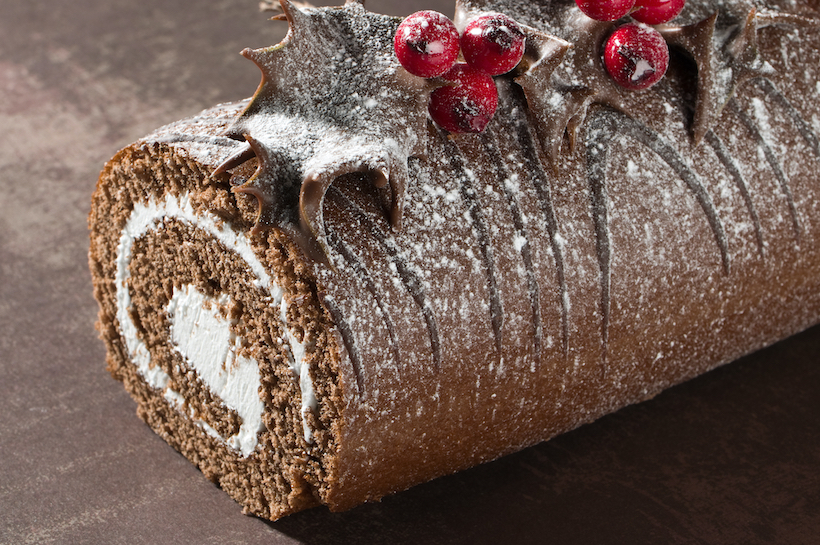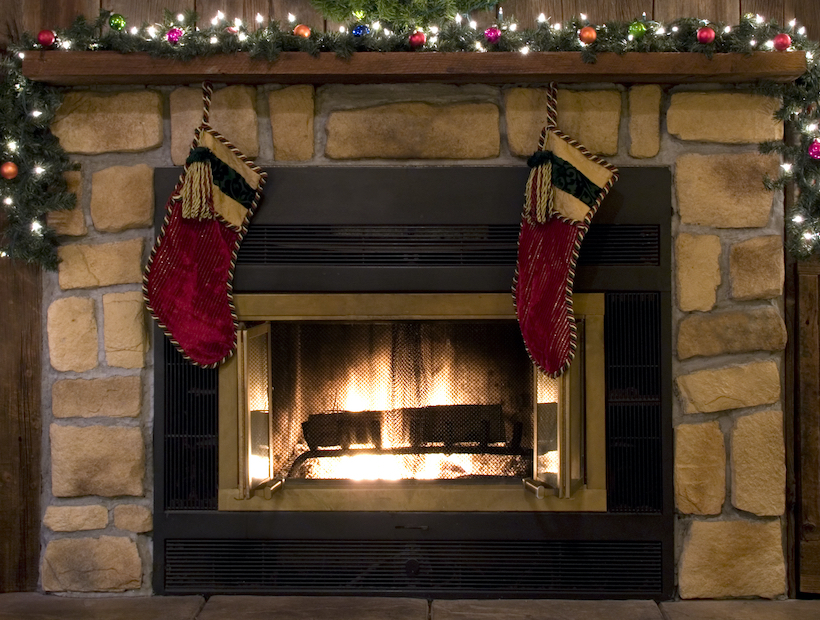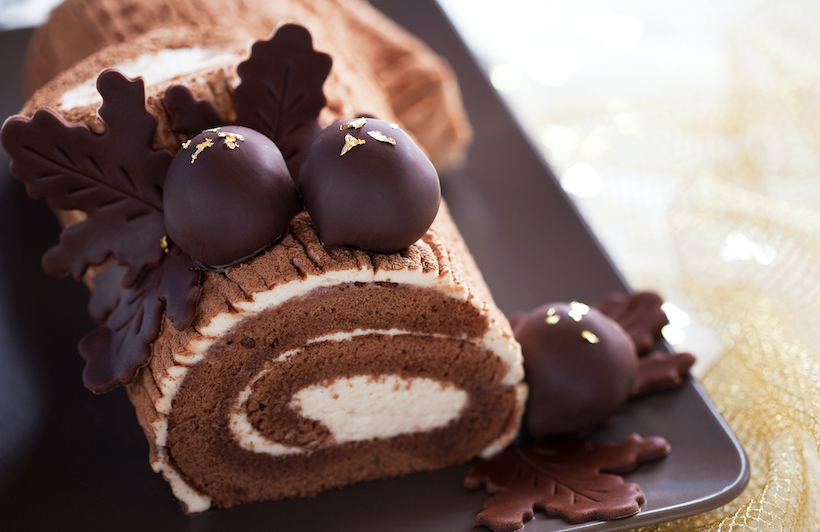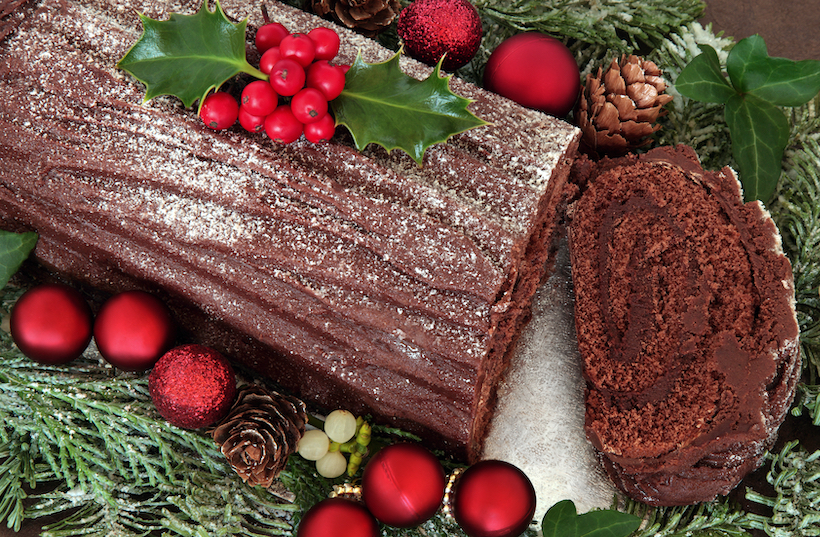Burning the Yule log is one of the oldest Christmas customs. In fact, it predates Christianity in pagan rituals that eventually merged with Christian holiday traditions in the early Middle Ages.
Today, few Americans still follow the Old World tradition of placing a tree on a hearth and burning it (...do you?).
However, the ritual has a modern popular—and edible—version, the Bûche de Noël (which means "Yule Log" in French). This holiday delicacy is a sponge cake with buttercream and chocolate that emulates the look of a traditional Yule log.
Let's take an in-depth look at the history of the Yule log tradition... and especially at how it morphed into a delicious holiday dessert.

The word "Yule" derives from the winter solstice festivals of followers of Old Norse and related Germanic pagan religions (such as the Anglo-Saxons). They were celebrated – generally across much of Northern Europe – dating to pre-Christian times. The Old Norse word "Jól" refers to to the Norse midwinter feast Jólablot. The term became the Old English "ġéol" and the Old French "jolif," related to the festivity of the season—from which the modern English word "jolly" derived.
During late December and early January on the Germanic lunar calendar, the twelve-day winter solstice festivals celebrated the switch to lengthening days.
As time went by, and as the Roman Empire spread widely, Yule's timing also coincided with the feast of Sol Invictus. This Roman religious fete, which Emperor Aurelian officially started on December 25, CE 274, celebrated the sun god of the later Roman Empire, who was also a patron of soldiers.
In the third or fourth century CE, the Christian Church decided to celebrate the birth of Jesus Christ on December 25, which coincided with both the Sol Invictus and the winter solstice festivals. Church officials may have wanted the new holiday to merge with existing pagan festivals honoring Mithra (Persian god of light) and Saturn (Roman god of agriculture).
This alignment occurred when Roman rulers and the Catholic Church were establishing Catholicism as the Holy Roman Empire's official religion. Incorporating existing holidays is one way Rome's subjects may have been more inclined to accept the new religion. The Feast of Epiphany co-occurs with the twelve-day pagan Yule holiday.
Over time, Christians celebrating the birth of Jesus adopted many of the winter solstice festivals' secular traditions. Today, Yule is a general term for Christmas throughout the British Isles. The term "Yuletide" refers to the Christmas season.

Initially, a Yule log was the trunk of a tree that played an integral part during the winter solstice celebrations. The Yule log-burning tradition involved bringing a Yule log into a home and placing the large end inside the fireplace to feed a fire that would last throughout the 12 days of Christmas.
Lighting the Yule log was a symbol of the sun's return after the winter solstice. Families believed that the log would protect their homes from fire and lightning—in some cultures, families kept the remaining burned log underneath the homeowner's bed. Families used the log from the previous year to light the new one, and, once lit, the log had to burn for 12 days.
Burning the Yule log accumulated many rituals, which varied from culture to culture throughout Europe. However, you had to source a yule log yourself. Buying a yule log was unlucky since, in many cases, sourcing a yule log was a family tradition. Wanted to have a prosperous year as a log-less new household? Better source a yule log from your own land!
Sir James G. Frazer, the author of The Golden Bough (1890), believed that burning the Yule log originated in early Northern European beliefs from the 4th century, which drew a parallel between the oak tree and the god of thunder. The evidence of this? Oak is the most commonly used wood for Yule logs and the belief that burning the Yule log protects a house from lightning.
Others believe that the Yule log had a purely practical origin. To survive the northern European cold, families dragged large logs into their homes and kept them burning for days. It was only natural that they encoded the practice in rituals.
Over time, different variations of Yule log burning developed throughout Europe. In countries such as England, France, and among the South Slavs of Eastern Europe, the tradition flourished. In some countries, burning the Yule log remains a solemn occasion up until today. In many Christian households, rituals such as lighting candles (maybe in a 'log' candle holder) take the place of the Yule log, but without the beliefs that surrounded the custom.
After Pope Julius I declared December 25 to be the official Christmas date, Christians adopted many of the pagan traditions of Dies Natalis Solis Invicti. To this day, many of the customs surrounding Yule are an integral part of modern Christmas celebrations.
The integration of Yule customs into Christmas was mainly due to the celebrations' coinciding dates and other influences. For example, Haakon the Good of Norway declared that everyone should have ales with a measure of grain during Christmas.
After the Reformation, many Christians became apprehensive about incorporating the pagan customs into their Christmas celebrations, and burning the Yule log became one of these traditions.
Today, burning the Yule log is mostly an outdated custom, especially in America. Modern homes don't all have fireplaces, and finding logs can be challenging, especially for those living in metropolitan areas. In short, we can't just head into our backyards to fell trees anymore.
Napoleon Bonaparte also played a role in the decline of the Yule log. During the early 1800s, Napoleon noticed that burning logs indoors made people ill, and he objected to the custom. The French responded with the Bûche de Noël, one of the heroes of this story: a pastry shaped like a Yule log.

La Bûche de Noël (Christmas log) is an edible Yule log, a traditional French dessert that follows the main Christmas dinner. The dish is a roll of sponge cake and cream layers with a coffee buttercream or chocolate covering.
La Bûche de Noël is popular worldwide but especially in France, Switzerland, and Belgium. In modern times, the Bûche de Noël has gained popularity in the United States as well. Different variations of Christmas logs exist, but they all have a long, cylindrical profile that looks like a log.
The exact origins of the edible Yule log are unknown. However, theories exist that the Bûche de Noël's creator was the personal baker of Charles III of Monaco, Pierre Lacam. He certainly may have been the first to write it down; you can find his recipe in Le Mèmorial Historique et Gèographique de la Pâtisserie. Other possible inventors of the edible Yule log include an apprentice baker in Paris and a baker who worked for Colibri in 1945.
But, Pierre Lacam is the most likely to have created the Bûche de Noël. The Yule log-burning tradition had started fading by the end of the 1800s, and it is likely that this incentivized Lacam to come up with an alternative. Lacam published the first Yule log cake recipe in 1895 in his cookbook.
Most people agree that the original Bûche de Noël was a Genoise sponge cake with a chocolate and coffee buttercream spread. The covering was buttercream with scratches to create a bark pattern.
Throughout the 20th century, every Bûche de Noël was more or less the same – a sponge cake with coffee and chocolate buttercream. Today, you can find many different dessert variations, including ice cream logs and even fruitcakes. New recipes also have gingerbread frostings and eggnog in their ingredient lists.
Traditionally, the covering or frosting has a bark-like texture to resemble a real Yule log. Many people enjoy adding nature-invoking features such as meringue mushrooms, sugar leaves, sugar cobwebs, and marzipan holly sprigs to give the log a realistic appearance.
Over time, Christmas log decorations also became more minimalistic, especially in the United States. In countries such as France, Scandinavia, and Switzerland, bakers usually stick to authentic decorations.

The Yule log for the fireplace has been most popular in the Northern Hemisphere, where the December solstice and Christmas celebrations are in the cold winter season. In European countries such as France, Switzerland, Belgium, and the Scandinavian countries, Yule logs remain a significant part of Christmas traditions.
Nowadays, Yule logs are no longer large tree trunks that people drag into their homes and burn in hearths. Instead, people sometimes take small enough logs to double as a centerpiece, then decorate them with cloves, winter greenery such as mistletoe, and pine cones. The log may also contain holes for candles to provide ambient lighting.
Edible Yule log cakes are also now popular in the United States. While the Bûche de Noël was not a traditional dessert in the United States, many families today now incorporate it into their Christmas dinners. The dish has also become a popular centerpiece for corporate Christmas events and large family gatherings.
In 1966, New York City television station WPIX started airing a television show called simply "The Yule Log." The show was a film loop of a yule log burning in a fireplace while classic Christmas music played in the background.
In densely populated cities, people generally don't have fireplaces to create an ambient holiday atmosphere, and the show solved their problem. The Yule Log was highly successful and aired every Christmas until 1989.
Today, people can purchase digital software for their computers or cast onto their TV screens, or they can play looping Yule Log YouTube videos—all of which show logs burning in a fireplace, complete with sound effects.
Numerous Christmas carols reference Yule logs and Yuletide, including "Deck the Halls." Yule logs also feature in the seasonal block of the Hallmark Channel called "Countdown to Christmas." The block airs holiday-themed programming and various holiday movies, several of which show the Yule log-burning custom.
In Season 8 of the "Great British Bakeoff," bakers had to create a Yule log. The winner of the signature challenge was Paul Jagger with his "Nutty About Christmas" Yule Log. Val Stones made a Black Forest Yule Log, and Beca Lyne-Pirkis made a Gingerbread Latte Yule Log.

The Yule Log dates back an incredibly long time, and it's fascinating to trace its evolution to the cake we eat today. To imagine a 12-day fireplace ritual evolved to a camera pointed at a burning log streamed to people in apartments: it's a lot to take in!
So, if Jack Frost is nipping at your nose, and yuletide carols are being sung by a choir, know the yule log is here to stay.